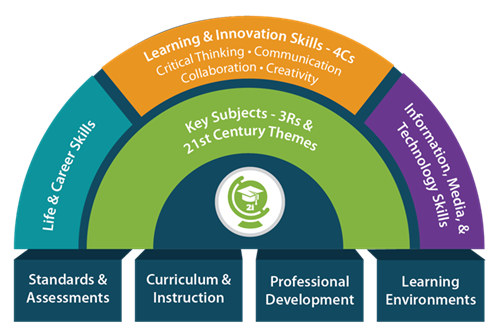The P21 Framework is a model for incorporating 21st century skills into learning. It was developed by a coalition of the US Department of Education, businesses including Apple, AOL, Microsoft, Cisco, and SAP, and organizations involved in education such as the NEA. Collectively, this coalition is known as the Partnership for 21st Century Learning. It was first published in 2006 and has been continuously updated, most recently in 2015.
Overall Goal
This framework was created to combine a set of competencies that emphasizes 21st Century Skills for students and supports teachers in teaching those skills. It uses core academic subjects as a vehicle for teaching life and career skills, learning and innovation skills, and information and media skills. These skills allow students to be better-prepared for today’s highly collaborative, innovation-focused workforce. For this reason, student outcomes in this framework are often described in terms of the future impact they will have for students when they seek employment.
P21 has the advantage of being a very general framework. It covers a lot of subjects and many potential strategies to train teachers and influence student outcomes. Its broad base allows it to be easily adaptable for both in-school and out-of-school activities. Details on the components of each of these outcomes are available on the P21 website.
Theoretical Basis
Much of the P21 Framework’s basis comes from a belief that children need the proper opportunities and avenues to gain the skills for careers.The coalition formed in an attempt to better prepare children for the challenges of the modern working world, and this framework is motivated by a desire for college and career-oriented education. The skills that the P21 lists are considered crucial for success in the workplace by all sectors.
The foundation believes that work environments are more complex in today’s society, so students must be able to integrate the traditional academic core with interdisciplinary skills that are more reflective of those complexities. They will gain these skills by integrating core content and interdisciplinary themes, and engaging in activities that promote Creativity, Critical Thinking, Communication, and Collaboration–the P21’s research-based 4C’s. Many of these opportunities for integrating core knowledge and critical thinking skills stem from technological literacy and related areas like media literacy. These literacies are translated into a list of competencies that students should master by the time they leave school.
Competency Basis
The core academic subjects include traditional subjects (Language arts, math, science, history, etc.) as well as a cluster of interdisciplinary subjects including Global Awareness, Financial, Economic, Business, and Entrepreneurial Literacy, Civic Literacy, Health Literacy, and Environmental Literacy. These competencies measure the outcomes of student learning.
P21 recommends that instruction in these subjects incorporate opportunities for students to also gain additional competencies critical for success in the 21st century:
- Learning and Innovation Skills (the so-called 4Cs) are Creative Thinking, Collaboration, Communication, and Critical Thinking and Problem Solving. These skills were picked for their use in complex work environments. Many of these skills have a design thinking flavor to them.
- Information, Media, and Technology Skills are the tools that students will learn to master both digital and non-digital media. Media is used as a creative tool, but also as an object to be evaluated for accuracy, effectiveness, and ethical considerations.
- Life and Career Skills are the habits and mindsets that students should develop when they learn from this framework. Some of these skills are internal, while others are based on interactions with others. These skills include accepting feedback, working in teams, and adapting well to change.
Instructional Approach
This framework is primarily directed toward in-school interventions, but it can be applied to out-of-school activities as well.
Support systems are the portion of the P21 Framework designed to give teachers the tools to influence student outcomes. They include guidelines for assessments, professional development, and learning environments to ensure teachers are prepared to work within the framework.These systems are designed to encourage teachers to create lessons and assessments based on the key subjects, while involving technology, and inquiry- and problem-based learning in lesson delivery to help students build 21st century skills.
P21 highlights Exemplar Schools who are evaluated based on their implementation of the core content, use of engaging teaching methods, and presence of the following support systems.
- Standards and Assessments focus on the skills associated with 21st Century content and measure mastery through standardized testing, inquiry- and project-based learning, and portfolio development. Assessments can also be enhanced by technology to provide students with a new medium for creative expression and feedback from the teacher.
- Curriculum and Instruction teaches 21st Century Skills as both individual competencies and as tools to be used to navigate the core curriculum.
- Professional Development gives teachers the skills to integrate 21st century themes into core content through projects and inquiries and to support that integration with technology.
- Learning Environments support teachers who collaborate and create relevant learning experiences for students involving 21st century skills. Well-planned environments encourage group work and provide equitable access to technology.

Method of Assessment
P21 advocates for a variety of assessments, including standardized testing and project and problem-based assessments. Additionally, P21 assesses schools by allowing districts to apply to be considered Exemplars.
Example: Avonworth School District
The P21 Framework awarded Avonworth School District with the title of “Exemplar School” thanks to their effective use of the framework in curriculum design. Tom Ralston, Superintendent, says the framework “has helped our educators to view learning through an important lens that embeds collaboration, critical thinking, creativity, and communication into learning experiences for children.” He saw its adoption as a way to make sure the district’s students are trained as the problem solvers and self-guided learners that are needed in today’s workforce. The district has created experiences that introduce teachers to community members working in fields related to their content area to help them create innovative, relevant lessons. Ralston has helped create an environment where teachers feel they can take risks in their lessons to help students develop the positive characteristics that will help their students succeed. “The acknowledgement that Avonworth High School has been recognized as a P21 Exemplar School is a wonderful affirmation of the educational program that our teachers and administrators facilitate for students,” says Tom. The P21 Exemplar status has been a source of pride for the district, and it has helped them work to prepare students for the future.
